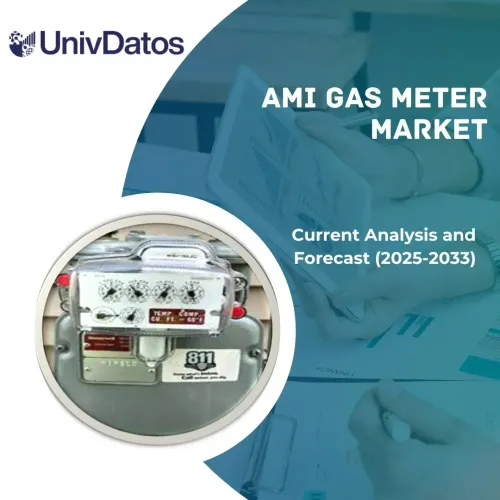- Home
- About Us
- Industry
- Services
- Reading
- Contact Us
Tire Derived Fuel Market: Current Analysis and Forecast (2023-2030)
Emphasis on Type (Shredded Tire and Whole Tire), Application (Pulp and Paper Mills, Cement Manufacturing, Utility Boiler, and Others)), Application (Power Generation, and Impoundment), End User (Passenger Vehicle, Commercial Vehicles, and Others) and Region/Country

Tire Derived Fuel Market Size & Forecast
The Tire Derived Fuel Market was valued at USD 299.39 Million and is expected to grow at a strong CAGR of around 4.6% during the forecast period (2023-2030) owing to the rising prevalence of limb loss.
Tire Derived Fuel Market Analysis
This growth is driven by the number of vehicles on the road rising globally, so does the generation of scrap tires. TDF offers a way to utilize this waste product. TDF offers a higher heating value than coal or wood, making it an attractive alternative fuel source for industries like cement manufacturing and power generation. Compared to coal, TDF can lead to lower sulfur oxide emissions which will help in climate change a curb the air pollution globally.
There are also some challenges facing the TDF market:
Stringent regulations: Burning tires can release harmful emissions if not done properly. Regulations around emissions control can make it difficult for some facilities to utilize TDF.
Public perception: There are concerns about the environmental impact of burning tires, which can hinder wider adoption.
Overall, the tire-derived fuel market has potential for growth, driven by the increasing waste tire problem and the fuel’s high heating value. However, stricter regulations and public perception remain challenges.
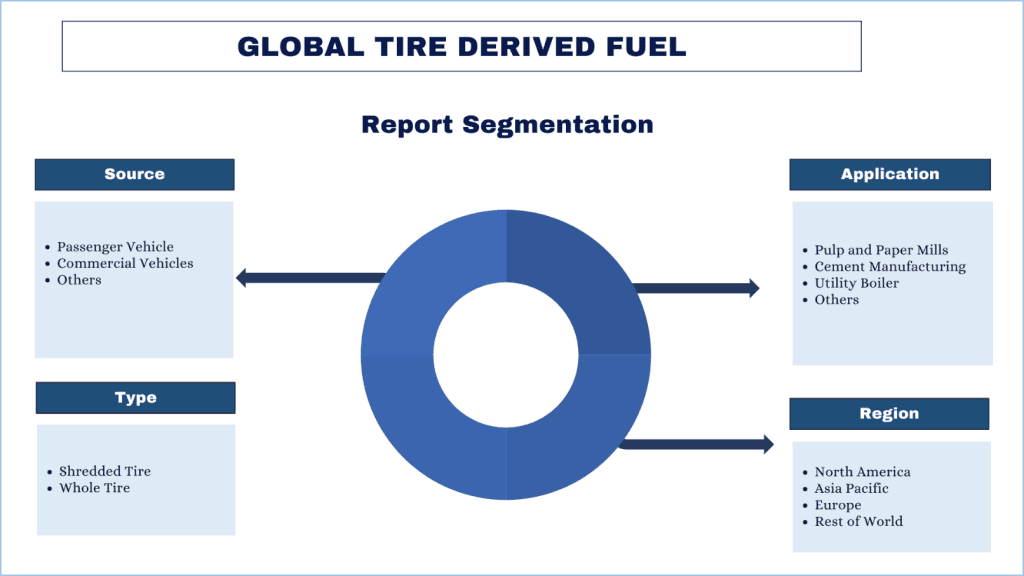
Tire Derived Fuel Market Trends
This section discusses the key market trends that are influencing the various segments of the Tire Derived Fuel Market as identified by our team of research experts.
An increased focus on sustainability is a major trend driving the growth of the tire-derived fuel (TDF) market.
Globally, a massive amount of scrap tires is generated. These tires pose environmental hazards when are stockpiled in landfills and take up valuable space. TDF offers a sustainable solution by transforming this waste into a usable fuel source. Stricter regulations and a growing focus on responsible waste management incentivize finding alternatives to landfills for used tires. TDF diverts tires from landfills, reducing their environmental impact. Furthermore, TDF promotes a circular economy by keeping waste tires in use. Instead of ending up in landfills, they are reintroduced into the economic cycle as a valuable fuel source. Fossil fuel dependence is a major contributor to climate change. TDF offers a more environmentally friendly alternative fuel option.
How Sustainability Fuels Market Growth:
As the focus on sustainability is growing, the regulations and consumer pressure is causing the industries to explore alternative fuel sources. TDF emerges as a viable option that aligns with sustainable practices. Companies that adopt TDF can potentially reduce their environmental footprint and enhance their brand image, giving them a competitive edge. Furthermore, increased public awareness about the environmental benefits of TDF can further drive market acceptance and demand for TDF from industries.
Sustainability is likely to remain a dominant force shaping the tire-derived fuel market. As environmental concerns continue to rise, TDF’s ability to address waste management challenges and offer a more sustainable fuel source will be a significant growth driver.
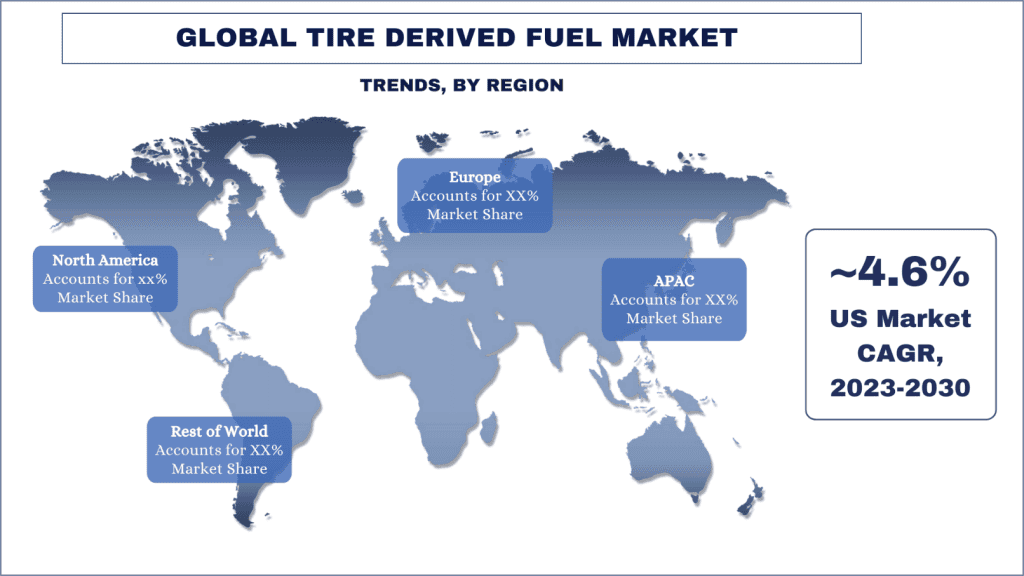
Asia Pacific is Expected to Grow with a Significant CAGR During Forecast Period.
Asia Pacific is indeed experiencing significant growth in the tire-derived fuel (TDF) market due to countries like China and India, which experiencing growth in automobile production and sales. Due to the increase in vehicle sales, there is a massive increase in scrap tires generated each year which is creating a readily available feedstock for the TDF market. Governments in several Asia Pacific countries are implementing stricter environmental regulations and policies that encourage sustainable waste management practices which includes promoting the use of alternative fuels like TDF to reduce reliance on landfills and traditional fossil fuels. Furthermore, developing economies in Asia Pacific are looking for economic alternatives. TDF presents a cost-competitive alternative to conventional fuels like coal, and a attractive option for industries seeking to optimize their fuel budgets. The Asia Pacific region is experiencing advancements in TDF processing technologies. This allows for more efficient and cleaner TDF production, making it a more environmentally responsible choice for industries.
Tire Derived Fuel Industry Overview
The tire derived fuel market is competitive and fragmented, with the presence of several global and international market players. The key players are adopting different growth strategies to enhance their market presence, such as partnerships, agreements, collaborations, new product launches, geographical expansions, and mergers and acquisitions. Some of the major players operating in the market are Renelux Cyprus, LS Tire LLC., Tire Disposal & Recycling., Ragn-Sells Group, Reliable Tire Disposal, Scandinavian Enviro System, Liberty Tire Recycling, Lakin Tire West, GLOBAL TIRE RECYCLING OF SUMTER CO, and ResourceCo.
Tire Derived Fuel Market News
- 2022: Neste, a renewable fuels company, announces a partnership with a Finnish waste management firm to explore co-processing TDF with waste plastics.
- The United States Department of Energy awards grants to several research projects focused on developing advanced TDF processing technologies.
- 2023: A joint venture between two Japanese companies establishes a new facility utilizing microwave-assisted pyrolysis for tire recycling.
- The European Union introduces stricter regulations on waste tire disposal, further incentivizing the use of TDF as a sustainable alternative.
Tire Derived Fuel Market Report Coverage
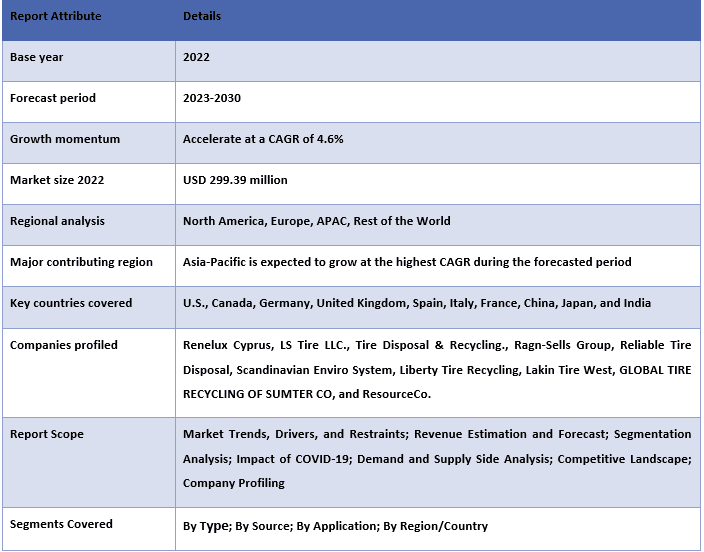
Reasons to buy this report:
- The study includes market sizing and forecasting analysis validated by authenticated key industry experts.
- The report presents a quick review of overall industry performance at one glance.
- The report covers an in-depth analysis of prominent industry peers with a primary focus on key business financials, product portfolios, expansion strategies, and recent developments.
- Detailed examination of drivers, restraints, key trends, and opportunities prevailing in the industry.
- The study comprehensively covers the market across different segments.
- Deep dive regional level analysis of the industry.
Customization Options:
The global tire derived fuel market can further be customized as per the requirement or any other market segment. Besides this, UMI understands that you may have your own business needs, hence feel free to contact us to get a report that completely suits your requirements.

You can also purchase parts of this report. Do you want to check out a section wise
price list?
Table of Content
Research Methodology for the Tire Derived Fuel Market Analysis (2023-2030)
Analyzing the historical market, estimating the current market, and forecasting the future market of the global tire derived fuel market were the three major steps undertaken to create and analyze the adoption of tire derived fuel in major regions globally. Exhaustive secondary research was conducted to collect the historical market numbers and estimate the current market size. Secondly, to validate these insights, numerous findings and assumptions were taken into consideration. Moreover, exhaustive primary interviews were also conducted, with industry experts across the value chain of the global tire derived fuel market. Post assumption and validation of market numbers through primary interviews, we employed a top-down/bottom-up approach to forecasting the complete market size. Thereafter, market breakdown and data triangulation methods were adopted to estimate and analyze the market size of segments and sub-segments of the industry pertains to. Detailed methodology is explained below:
Analysis of Historical Market Size
Step 1: In-Depth Study of Secondary Sources:
Detail secondary study was conducted to obtain the historical market size of the tire derived fuel market through company internal sources such as annual reports & financial statements, performance presentations, press releases, etc., and external sources including journals, news & articles, government publications, competitor publications, sector reports, third-party database, and other credible publications.
Step 2: Market Segmentation:
After obtaining the historical market size of the tire derived fuel market, we conducted a detailed secondary analysis to gather historical market insights and share for different segments & sub-segments for major regions. Major segments are included in the report as type, source, and application. Further country-level analyses were conducted to evaluate the overall adoption of testing models in that region.
Step 3: Factor Analysis:
After acquiring the historical market size of different segments and sub-segments, we conducted a detailed factor analysis to estimate the current market size of the tire derived fuel market. Further, we conducted factor analysis using dependent and independent variables such as type, source, and application of the tire derived fuel market. A thorough analysis was conducted for demand and supply-side scenarios considering top partnerships, mergers and acquisitions, business expansion, and product launches in the tire derived fuel market sector across the globe.
Current Market Size Estimate & Forecast
Current Market Sizing: Based on actionable insights from the above 3 steps, we arrived at the current market size, key players in the global tire derived fuel market, and market shares of the segments. All the required percentage shares split, and market breakdowns were determined using the above-mentioned secondary approach and were verified through primary interviews.
Estimation & Forecasting: For market estimation and forecast, weights were assigned to different factors including drivers & trends, restraints, and opportunities available for the stakeholders. After analyzing these factors, relevant forecasting techniques i.e., the top-down/bottom-up approach were applied to arrive at the market forecast for 2030 for different segments and sub-segments across the major markets globally. The research methodology adopted to estimate the market size encompasses:
- The industry’s market size, in terms of revenue (USD) and the adoption rate of the tire derived fuel market across the major markets domestically
- All percentage shares, splits, and breakdowns of market segments and sub-segments
- Key players in the global tire derived fuel market in terms of products offered. Also, the growth strategies adopted by these players to compete in the fast-growing market.
Market Size and Share Validation
Primary Research: In-depth interviews were conducted with the Key Opinion Leaders (KOLs) including Top Level Executives (CXO/VPs, Sales Head, Marketing Head, Operational Head, Regional Head, Country Head, etc.) across major regions. Primary research findings were then summarized, and statistical analysis was performed to prove the stated hypothesis. Inputs from primary research were consolidated with secondary findings, hence turning information into actionable insights.
Split of Primary Participants in Different Regions
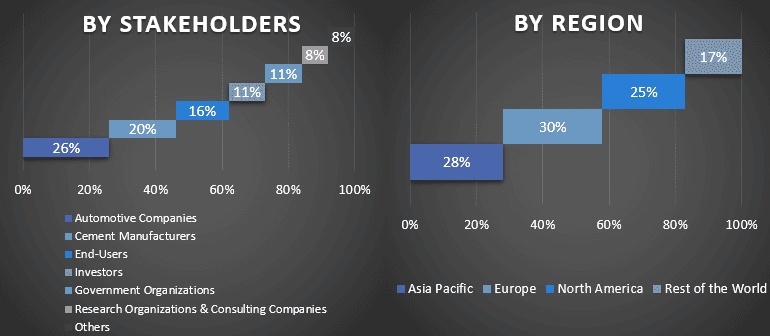
Market Engineering
The data triangulation technique was employed to complete the overall market estimation and to arrive at precise statistical numbers for each segment and sub-segment of the global tire derived fuel market. data was split into several segments & sub-segments post studying various parameters and trends in the areas of the type, technology, component, and end-user in the global tire derived fuel market.
The main objective of the Global Tire Derived Fuel Market Study
The current & future market trends of the global tire derived fuel market were pinpointed in the study. Investors can gain strategic insights to base their discretion for investments on the qualitative and quantitative analysis performed in the study. Current and future market trends determined the overall attractiveness of the market at a regional level, providing a platform for the industrial participant to exploit the untapped market to benefit from a first-mover advantage. Other quantitative goals of the studies include:
- Analyze the current and forecast market size of the tire derived fuel market in terms of value (USD). Also, analyze the current and forecast market size of different segments and sub-segments.
- Segments in the study include areas of the type, source, and application.
- Define and analysis of the regulatory framework for the tire derived fuel
- Analyze the value chain involved with the presence of various intermediaries, along with analyzing customer and competitor behaviors of the industry.
- Analyze the current and forecast market size of the tire derived fuel market for the major region.
- Major countries of regions studied in the report include Asia Pacific, Europe, North America, and the Rest of the World
- Company profiles of the tire derived fuel market and the growth strategies adopted by the market players to sustain in the fast-growing market.
- Deep dive regional level analysis of the industry
Frequently Asked Questions FAQs
Q1: What is the current market size and growth potential of the tire derived fuel market?
Q2: What are the driving factors for the growth of the tire derived fuel market?
Q3: Which segment has the largest share of the tire derived fuel market by type?
Q4: What are the emerging technologies and trends in the tire derived fuel market?
Q5: Which region will dominate the tire derived fuel market?
Related Reports
Customers who bought this item also bought

